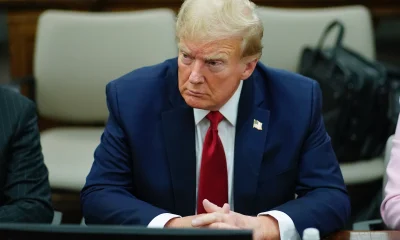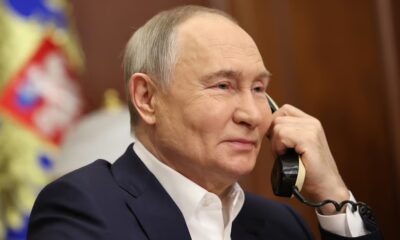Analysis
Putin’s Pivot to Libya: Russia’s New Stronghold After Losing Syria

With Assad’s fall in Syria, Russia sets sights on Libya as its next strategic base to sustain influence in the Mediterranean and Africa.
Russia’s Strategic Shift to Libya
The fall of Bashar al-Assad’s regime in Syria marks a significant turning point for Russia’s geopolitical ambitions. Having used Syria as a springboard for projecting power across West Asia and Africa for nearly a decade, Moscow is now recalibrating its regional strategy. With the loss of key bases like Tartus and Khmeimim, Russian President Vladimir Putin has turned to Libya as a critical alternative to sustain Moscow’s influence.
A New Base in Libya
Russia’s relocation efforts are already underway. Daily flights from Khmeimim airbase in Syria to Al Khadim airbase in Libya suggest a strategic pivot. Aircraft like the Antonov AN-124 and Ilyushin IL-76 are reportedly ferrying troops, equipment, and even advanced air defense systems to Libya. The Al Khadim base near Benghazi is poised to replace Khmeimim, while Russia is negotiating access to a port in Benghazi to fill the void left by Tartus.
If successful, these moves would grant Russia a foothold in the Mediterranean and a logistical hub for operations in Africa. Libya’s strategic location, fragmented governance, and willingness to cooperate with Moscow make it an attractive, albeit imperfect, substitute for Syria.
Why Libya Matters
Libya offers Russia several strategic advantages:
Access to Africa: A strong presence in Libya could facilitate Russian operations in Sudan, Chad, Niger, and the broader Sahel region, cementing Moscow’s role as a key player in Africa.
Mediterranean Reach: Control over air and naval bases in Libya allows Russia to project power in the Mediterranean, countering Western influence and safeguarding its energy and trade interests.
Defying the West: By consolidating its presence in Libya, Russia continues its broader geopolitical goal of challenging Western dominance, leveraging fragmented governance to secure military and economic footholds.
Challenges in Libya
While Libya presents opportunities, it is not without challenges:
Dependence on Turkey: Russian transport planes must overfly Turkey to reach Libya, giving Turkish President Recep Tayyip Erdogan significant leverage over Moscow.
Fragmented Governance: Libya’s internal divisions pose risks to long-term stability, with rival factions and external powers vying for influence.
Africa and Beyond
Russia’s shift to Libya signals a recalibration of its Africa strategy. By using Libya as a hub, Moscow can continue its involvement in resource-rich regions and maintain its engagement with client states like Mali and Burkina Faso. The move underscores Russia’s adaptability in the face of setbacks, ensuring its ambitions in Africa and the Mediterranean remain intact despite losing Syria.
The fall of Assad marks the end of an era for Russia’s Middle Eastern strategy but also the beginning of a new chapter in Libya. While the path forward is fraught with challenges, Moscow’s swift redeployment to Libya demonstrates its determination to retain influence and counter Western powers. Whether Libya can become the new Syria for Russia remains uncertain, but it is clear that Putin is unwilling to relinquish his hold on the region’s strategic dynamics.
Analysis
M23 Ceasefire in DRC: A Fragile Truce or a Tactical Pause?

As M23 halts its advance, fears loom over the sustainability of peace in eastern Congo.
M23’s sudden ceasefire declaration in the eastern Democratic Republic of the Congo (DRC) has paused the bloodshed—for now. The rebel group, which has wreaked havoc across the region, claims it is stopping its military operations for humanitarian reasons. But in a battlefield dominated by over 100 armed factions, many see this move as a temporary maneuver rather than a lasting peace effort.
The streets of Goma are tense but active. Aid groups are racing against time to assist thousands wounded and displaced by the recent onslaught of violence between M23 and pro-government militias. Meanwhile, in South Kivu, M23 fighters remain stationed just kilometers from Bukavu, their guns silent—for now.
This ceasefire follows urgent diplomatic intervention from the East African Community (EAC) and the Southern Africa Regional Community (SADC), who are now scrambling to forge a political solution. With Kinshasa and Kigali locked in an escalating dispute, regional leaders are set to meet in Tanzania in an attempt to de-escalate the crisis.
But the bigger question remains—is this truce real or just another strategic pause? U.N. agencies report that 770 bodies littered the streets of Goma, with 2,880 more injured, underscoring the brutal toll of this conflict. The Red Cross is struggling to collect the dead, while humanitarian groups plead for the Goma airport to be reopened to deliver medical aid and evacuate the critically wounded.
The biggest threat to this ceasefire? The Wazalendo and other militias not bound by the truce. These groups reject M23’s deal, and without their inclusion in peace talks, the cycle of war in the mineral-rich killing fields of eastern Congo will rage on.
Meanwhile, DRC President Félix Tshisekedi, who snubbed last week’s EAC summit, is now expected to face off with Rwandan President Paul Kagame at the upcoming regional crisis meeting. With Rwanda’s support for M23 already verified by the U.N., the chances of a lasting peace remain dangerously slim.
For now, the guns are silent. But in a region where ceasefires are often just another phase in the war, the question isn’t if the fighting will resume—but when.
Analysis
Dermer Steps In: A Power Move in Gaza Negotiations That Could Reshape the Middle East

Analysis
Trump’s Middle East Playbook: Expanding the Canvas to Cut a Deal

As Prime Minister Benjamin Netanyahu prepares to meet U.S. President Donald Trump, the stage is set for another high-stakes negotiation in the Middle East. Drawing from his 2017 strategy, Trump appears ready to broaden the diplomatic canvas to force movement on the Gaza war, hostage deals, and regional realignments.
Trump’s Game Plan: A Bigger Deal for a Bigger Concession
Trump’s Middle East policy has always been defined by thinking beyond traditional frameworks. In 2017, he abandoned the two-state orthodoxy, signaling openness to alternatives. Now, he seems poised to redefine the Israeli-Palestinian conflict by weaving it into a larger regional deal, which could involve Jordan, Egypt, and Gulf states.
The sticking point in the hostage deal negotiations remains Hamas’ demand for a full Israeli withdrawal from Gaza and an end to the war—something Netanyahu has categorically rejected. Trump’s approach? Offer Israel incentives to compromise by tying the deal to something far bigger: Saudi normalization, security guarantees, and population redistribution.
The “Refugee Relocation” Bargain
Trump’s most controversial proposal—convincing third countries to take in Gazan refugees—aims to ease pressure on Netanyahu’s fragile coalition. If Israel agrees to a ceasefire and limited withdrawal, Trump could leverage U.S. influence to pressure Gulf states into absorbing displaced Palestinians. This would not only weaken Hamas’ grip but also neutralize domestic Israeli opposition to a broader settlement.
Saudi Normalization: Netanyahu’s Escape Route?
Trump may also revive the Abraham Accords momentum, offering Saudi recognition of Israel as the ultimate prize—provided Israel makes limited concessions on Gaza’s governance. In 2020, Trump convinced Netanyahu to freeze West Bank annexation in exchange for peace deals with the UAE, Bahrain, and Morocco. Could he pull off a similar trade-off in 2025?
Netanyahu’s Political Dilemma
Unlike 2017, Netanyahu now faces serious constraints:
- A weakened domestic position due to judicial conflicts and the ICC arrest warrant threat.
- A right-wing coalition that opposes any compromise with the Palestinians.
- Hamas’ continued presence in Gaza, which complicates any ceasefire agreement.
While Trump’s deal-making instincts suggest a grand bargain is on the table, Netanyahu’s ability to sell it at home is highly questionable. If he accepts too many concessions, his government could collapse—but if he rejects Trump’s expanded vision, he risks alienating his most powerful ally.
Ultimately, Trump is playing the long game, and if his strategy of “expanding the canvas” succeeds, the Middle East could see a historic power shift—one that reshapes alliances, redraws battle lines, and alters the fate of Gaza’s population. The question remains: Will Netanyahu gamble on a bigger deal, or will his political reality force him into a corner?
Analysis
Senior ISIS Commander Captured in Puntland as U.S. Airstrikes Cripple Somalia’s Jihadist Network

Security forces in Puntland have captured Abdirahman Shirwac Aw-Saciid, the leader of the group’s assassination squad and a key operative in its extortion network. The arrest comes just two days after U.S. airstrikes targeted senior ISIS leadership, intensifying pressure on the group amid a growing Puntland offensive against both ISIS and Al-Shabaab.
A Crumbling Jihadist Network
Once seen as a fringe element compared to Al-Shabaab, ISIS-Somalia has rapidly expanded in recent years, fueled by foreign fighters and an enhanced financial system. The group has increasingly used sophisticated tactics, including booby-trapped vehicles, signaling an evolution in their operational capabilities.
Shirwac, also known as “Laahoor”, was captured in the Cal Miskaad mountains, a key hideout in Puntland’s Bari region, where the group has been entrenched. His role in assassination operations and extortion made him one of the most dangerous figures within Somalia’s ISIS faction.
Puntland’s Offensive and U.S. Military Support
The Puntland state government launched a full-scale offensive in December, targeting both ISIS and its longtime rival, Al-Shabaab. The Somali government, still struggling with decades of instability, sees Puntland’s campaign as a critical front in the battle against terrorism.
Meanwhile, U.S. airstrikes on Saturday in the Golis Mountains dealt another devastating blow to ISIS-Somalia, reportedly killing multiple high-ranking operatives. U.S. Secretary of Defense Pete Hegseth emphasized that these strikes were part of a broader strategy to dismantle ISIS’ global network.
The Bigger Picture: Somalia’s Security Crisis
While Al-Shabaab still remains the dominant jihadist force in Somalia, ISIS-Somalia has carved out a deadly foothold in Puntland and the northeast, leveraging extortion, smuggling, and foreign funding. The Somali government, backed by regional forces and U.S. military support, is racing against time to prevent ISIS from becoming an even greater threat.
The capture of Laahoor represents a significant victory for Puntland security forces. However, whether this momentum can be sustained—and whether Somalia can prevent an ISIS resurgence—remains the ultimate test. The war is far from over, but the tides may be turning against ISIS in Somalia.
Analysis
Somaliland’s Fire Crisis: Leadership, Recovery, and Repeated Failures

Somaliland’s markets are burning—and with them, the livelihoods of thousands. The Gobonnimo Market fire is just the latest in a series of catastrophic blazes that have devastated Hargeisa’s commercial hubs. Waaheen Market (2022), Wajaale Market (2023), and now Gobonnimo Market (2025)—all tell the same story of poor infrastructure, inadequate fire response, and a lack of preventive measures.
President Abdirahman Mohamed Abdullahi Cirro, alongside senior government officials, visited the scene, expressing sorrow and pledging government support. His call for national unity and fundraising reflects Somaliland’s resilience, yet the larger question remains unanswered—why do these fires keep happening?
The Waaheen Market inferno of 2022—the worst in decades—took 16 hours to control, destroying 2,000 shops, 100 buildings, and displacing countless families. In 2023, the Wajaale Market fire caused losses worth $5.3 million, once again proving Somaliland’s economic hubs are high-risk zones without adequate fire protection.
The repeated devastation has sparked public frustration, with demands for transparent investigations into causes, accountability, and prevention. The formation of a technical committee to assess damages is a delayed reaction, not a preventive solution. Somaliland’s economy relies on trade, yet its commercial centers remain vulnerable to fires that could be avoided with better urban planning and safety protocols.
Without modernized fire safety regulations, clear urban zoning, and rapid response infrastructure, Somaliland will continue to relive this nightmare—again and again. The government’s next step must not be just compensation and damage control; it must be prevention.
Analysis
EU Courts Trump with China Strategy Amid Greenland Shockwaves

The European Union is making a calculated move to appease President Donald Trump by offering a united front on China, hoping to salvage strained transatlantic relations. With Trump staking an audacious territorial claim on Greenland—a protectorate of Denmark—and threatening devastating 20% tariffs on European goods, Brussels is scrambling to find common ground before the relationship implodes.
EU Trade Commissioner Maroš Šefčovič has laid out a proposal to strengthen economic security in partnership with Washington, emphasizing the shared challenge of China’s state-subsidized economic model. This echoes Trump’s first-term collaboration between the U.S., EU, and Japan to counter Beijing’s trade practices, which Brussels now sees as a crucial bargaining chip to keep Trump engaged.
The EU is not just talking trade—it’s offering cash flow. European Commission President Ursula von der Leyen has already floated the purchase of more U.S. liquefied natural gas (LNG) to reduce reliance on Russian gas, a move designed to win favor with Trump while securing energy independence.
But will this gamble work? Trump thrives on disruption, and his territorial ambitions over Greenland signal a willingness to bulldoze alliances to reshape global power dynamics. While Brussels tries to pivot toward a mutually beneficial economic security pact, Trump’s instinct for unilateral action remains the wild card. With an EU-China showdown looming in May, the next few months could determine the fate of Europe’s precarious balancing act between Washington and Beijing. Trump holds the cards—will Brussels play the right hand?
Analysis
Rwanda-Backed Rebels Tighten Grip on Eastern Congo, Threaten March to Kinshasa

M23 rebels, emboldened by Rwandan military support, have taken control of Goma, eastern Congo’s largest city, and are threatening to advance on Kinshasa, escalating one of Africa’s most dangerous conflicts. With 4,000 Rwandan troops reportedly backing them, the rebels have far more firepower than in 2012, when they briefly seized Goma before withdrawing under international pressure.
Congo’s President Félix Tshisekedi has rejected any negotiations, calling for a nationwide military mobilization while ordering his defense minister to burn any proposals for talks. The fear of a full-scale regional war is growing, as tensions between Rwanda and South Africa escalate after 13 South African peacekeepers were killed in the violence. Rwanda’s President Paul Kagame has issued a veiled warning, stating that “if South Africa prefers confrontation, Rwanda will deal with the matter in that context any day.”
Goma has fallen into chaos, with dead bodies in the streets, widespread looting, and thousands of government troops surrendering or fleeing. Residents describe soldiers shedding their uniforms, dropping their weapons, and either escaping to Rwanda or seeking refuge at U.N. bases. Meanwhile, in South Kivu, where the rebels are advancing, fear grips the population as gunfire and explosions draw closer to Bukavu.
The U.S. and U.N. have called for a ceasefire, but Congo’s government remains defiant, seeing Rwanda’s aggression as an existential threat. With $24 trillion in untapped minerals at stake, the battle for Congo’s east is no longer just about rebel groups—it is a geopolitical proxy war with massive consequences for Africa and the global economy.
The clock is ticking, and the risk of all-out war is closer than ever.
Analysis
Trump’s Intelligence Pick Goes to War with ‘Deep State’ Critics

Tulsi Gabbard isn’t playing by Washington’s rules. Standing before the Senate Intelligence Committee, Trump’s pick for Director of National Intelligence came out swinging—calling out intelligence failures, political weaponization, and what she sees as a corrupt system determined to protect itself at all costs. The hearing wasn’t just about confirming her—it was a battleground for a much larger war over who controls the truth in Washington.
Gabbard’s nomination has stunned both parties. A former Democrat who broke ranks, a combat veteran without deep intelligence credentials, and a fierce critic of U.S. foreign policy blunders, she’s everything the intelligence establishment despises. But Trump loves outsiders, and Gabbard fits his mold—a disruptor who isn’t afraid to call out the system’s “costly failures”.
Her testimony was a direct attack on the “weaponization of intelligence”, which she claims has been used to undermine Trump since 2016. She framed her mission clearly: restore credibility to an intelligence community that the American people no longer trust. The hearing quickly turned into a firestorm. Critics hammered her on past comments about Snowden, Ukraine, and her controversial meeting with Syria’s Bashar al-Assad. But Gabbard stood her ground.
She dodged calls to label Edward Snowden a traitor, arguing that his leaks exposed illegal government actions. When pressed on Ukraine, she reversed her 2022 claim that NATO provoked Russia’s invasion, now calling Putin an aggressor. As for Assad, she defended her trip, insisting it was about seeking the truth—an explanation that did little to appease her skeptics.
The intelligence world is watching with unease. Her past criticisms of surveillance programs, her skepticism of interventionist wars, and her willingness to challenge conventional narratives make her an unpredictable force. The Deep State accusations aren’t just coming from conspiracy theorists—Trump’s allies, including Elon Musk, are openly backing her, seeing her as a rare chance to dismantle the intelligence-industrial complex from within.
The Senate is divided. Some see Gabbard as a much-needed disruptor in a broken system. Others fear she is too much of a wildcard, too willing to question the U.S. security establishment in an era of global threats. But one thing is clear: if confirmed, Gabbard won’t be a quiet administrator. She’ll be a wrecking ball aimed straight at the intelligence community’s most protected secrets.
-

 Somaliland1 week ago
Somaliland1 week agoSomaliland and UAE Elevate Ties to Comprehensive Strategic Partnership
-

 Africa10 months ago
Africa10 months agoHow Somaliland Could Lead the Global Camel Milk Industry
-

 Analysis10 months ago
Analysis10 months agoIran escalates conflict, attacking Israel; US forces help Israel to intercept Iranian projectiles
-

 Analysis10 months ago
Analysis10 months agoIsrael and Iran on Edge: Tensions Escalate Amidst Rising Threats
-

 Top stories8 months ago
Top stories8 months agoGunmen Kill 11 in Southeastern Nigeria Attack, Army Reports
-

 Analysis10 months ago
Analysis10 months agoFacts in the Trump Courtroom vs. ‘Facts’ in the Court of Public Opinion
-

 Crime10 months ago
Crime10 months agoSomali USA Gangs: Deadly Twist in Shocking St. Paul Shooting
-

 Top stories10 months ago
Top stories10 months agoTrump’s Comparisons: Charlottesville Rally and Israel Protests






























